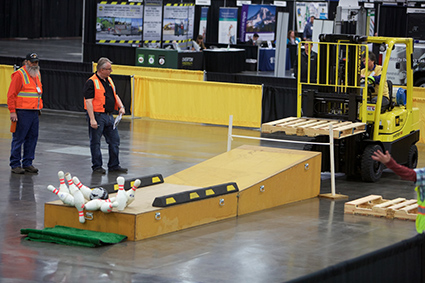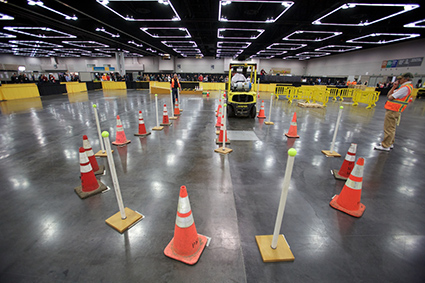At the “forklift rodeo” that took place March 11 during the Oregon Governor’s Occupational Safety and Health Conference, cowboy hats were replaced with hard hats, cowboy boots with safety boots, and horses with powered industrial trucks.
For the third time, Oregon OSHA sponsored a Forklift Challenge at the biannual conference. The competition features forklift operators from across the region testing their skills and precision at negotiating tight turns and stacking pallets.
“The objective is to raise the level of awareness of safe operations,” said Craig Hamelund, an Oregon OSHA training specialist. Hamelund, who spoke with me by phone from the conference in Portland, oversaw this year’s event. Thirty-five people participated, some as part of a team, some as individuals and some as both.
Participants maneuver the forklifts through about six different drills, including raising and lowering pallet racks or bins to precise locations, driving forklifts through cones set up to simulate narrow entry and egress, and weaving in and out of cones with and without loads. The final event entails raising a bowling ball and rolling it down a ramp in the hopes of knocking down pins.

Photo: Oregon GOSH Conference
The drivers are timed, and points are added to that time for every cone knocked over or other violations accrued during the drills. The driver or team with the lowest score wins.
So what’s a good strategy for winning? Go fast to have a quick time, or be careful not to have any violations? According to Hamelund, the best results come from finding a balance between the two.
“A person that’s focused on running the fastest ... I’ve never seen them win because they commit too many course violations,” he said. “But when someone is too careful and avoids the course violations, they’re too damn slow.”

Photo: Oregon GOSH Conference
The event is open to anyone trained in operating a forklift. Cash prizes ranging from $200 to $500 are awarded to winners, but Hamelund said the rodeo offers more than prize money and a bit of fun.
The rodeo mimics real-life forklift operations, particularly in achieving that balance between speed and safety. For many businesses, productivity is key, but safety cannot be ignored.
“Time is important, but the forklifts have to be operated at a speed that is reasonable, safe and can still achieve productivity,” Hamelund said. “In the real world, if you’re awfully quick, you’re going to bump into pedestrians.”
No pedestrians are at risk during the challenge – only cones. But the competition can help highlight safety for an operator. If a judge adds points to an operator for hitting a cone or failing to look over both shoulders while backing up, Hamelund said it reinforces to the forklift driver what’s important when it comes to safe operations.
Oh, and for any safety professionals who may be worrying about the risks involved with a forklift rodeo, Hamelund told me Oregon OSHA takes great care in creating a safe and controlled environment. Everyone on the floor wears high-visible materials and safety boots, the pallet racks and forklift horns are safety-checked, and carbon monoxide monitors are in place to ensure exhaust from propane-powered forklifts is within safe limits.
Other safety agencies in the United States and Canada have hosted similar events over the years. If you’re interested in hosting your own in-house rodeo and would like some help putting the event together, feel free to reach out to Hamelund at [email protected] or (503) 229-5910.
The opinions expressed in "On Safety" do not necessarily reflect those of the National Safety Council or affiliated local Chapters.

